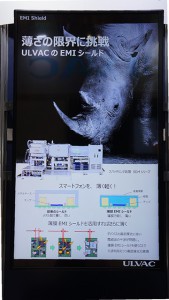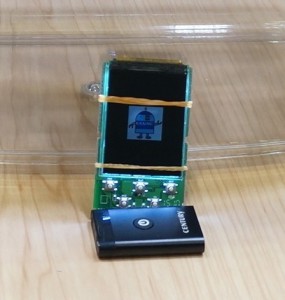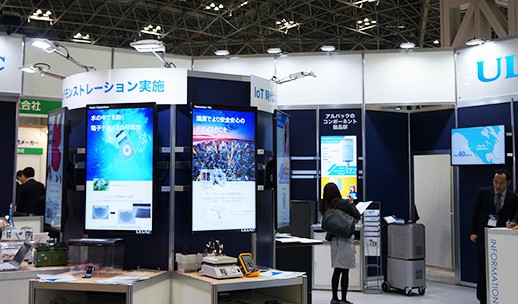This post is also available in: Japanese
ULVAC, a leading producer of vacuum technologies, exhibited its latest products and technologies in MEMS Technology Zone of FINETECH JAPAN, a technical exhibition that was held at Tokyo Big Site on April 6 to 8, 2016.
* This is an excerpt from an article that appeared in Mynavi news on April 11, 2016.
[Special edition] FINETECH JAPAN: State-of-the-art ULVAC technologies that support the IoT society [Japanese Site]

ULVAC’s core business involves producing vacuum technologies to provide high-quality production systems for various electronic parts, such as touch panels and thin-film batteries. The company exhibited its SDH series of sputtering systems that are used in the fabricating of thin films for electromagnetic interference (EMI) shields for the first time at FINETECH JAPAN.
Printed-circuit boards for smartphones and other mobile devices often contain both semiconductor chips that are vulnerable to external EMI and semiconductor chips that emit EMI. In such cases, EMI shielding is often provided by covering the EMI-emitting semiconductor chips with a metal cover.
However, since the use of metal covers means that large gaps are required between adjacent semiconductor chips, the size of the printed-circuit board as a whole will inevitably become larger. In addition, the height of the parts mounted on the board is increased due to the use of metal covers. This approach is, therefore, not appropriate for devices requiring a high-density chip arrangement, such as smartphones and other mobile devices. Given this, the application of an EMI shield by forming a metal film on the surfaces of the semiconductor chips (packages) instead of using metal covers has become increasingly common in recent years.
EMI shielding requires the deposition of a sufficiently thick film not only on the surface of packages containing devices such as semiconductor chips and electronic parts, but also on their sides. In addition, the temperature during the sputtering process must be regulated to keep it low to prevent damage to these devices.
ULVAC’s SDH series of sputtering systems satisfies these requirements for the film deposition used in forming an EMI shield, and it delivers very high productivity at the same time. At present, the company is receiving many inquiries from a variety of different areas.
Shift from exhibitions that mainly display systems to ones that allows visitors to experience technologies directly
At this FINETECH JAPAN, ULVAC presented their exhibition in a style that differs from conventional ones. ULVAC, a production system manufacturer, has mainly exhibited production systems in the past. Exhibitions of production systems are easy for the users of such systems to understand. However, if the systems are just displayed, visitors who specialize in tangential or peripheral fields and do not use the production systems themselves may have difficulty understanding them.
In light of this, ULVAC switched from an exhibition that displays the systems to one that displays concrete possibilities for the application of ULVAC’s technologies. This ambitious exhibition involved the performance of demonstrations that allowed visitors to directly experience technologies that will contribute to the realization of an IoT society.
ULVAC performed the following four types of demonstrations at FINETECH JAPAN.
(1) The operation in water of a completely sealed printed-circuit board equipped with semiconductors and electronic parts
(2) The operation of a temperature sensor and a wireless communication circuit by means of a thin-film solid-state battery (thin-film battery)
(3) The measurement of weak biomagnetism without a magnetic shield by using a tunneling magnetoresistance (TMR) element
(4) The demonstration of a high-performance material (thermistor) whose electric resistance rapidly changes in response to the temperature
Portable audio players that operate effectively in water

Demonstration (1) exhibited a concrete technology for protecting the sides and the rear face of a complex three-dimensional shape from liquids and dust by completely covering it with an insulating thin film. For this demonstration, a portable audio player whose printed-circuit board, battery, liquid crystal panel, and other parts had been sealed with a protective film was operated in water.
Water itself does not conduct electricity, but ordinary water (e.g. tap water and bottled water) does contain impurities, which readily conduct electricity with the aid of the ions that they contain. Accordingly, if a printed-circuit board or some other electronic part is submerged in water, the electric circuit becomes inoperative due to a short circuit between the electrodes.
If it is necessary for an electric circuit to be operative underwater, the entire circuit must be covered with an insulating thin film, for example. A typical method for depositing such a film is the gas phase method. However, this method is disadvantageous in that the film grows almost entirely on the upper face. For a complex irregular shape, almost no thin film grows on the sides or the rear face.
In the demonstration, the evaporation polymerization method of depositing an insulating polymer was used to overcome this problem. This method involves making use of a chemical reaction that occurs on the surface to grow a thin film, thereby allowing the entire surface—including the sides and rear face—to be coated with a film of uniform thickness even if it has a complex shape.

